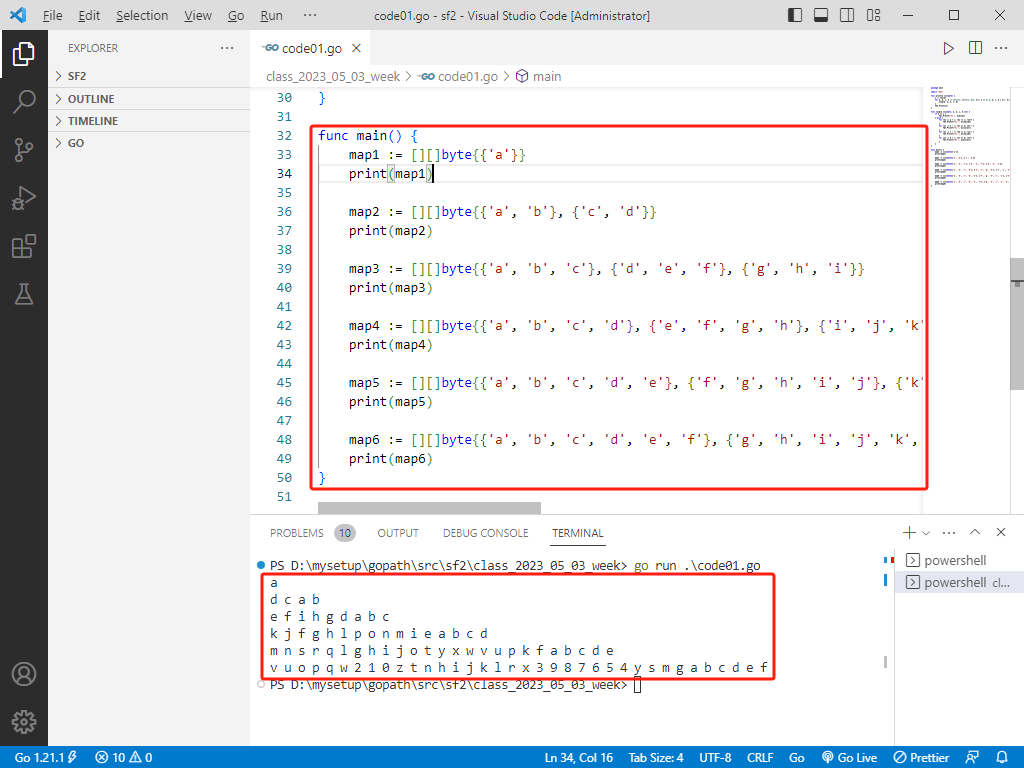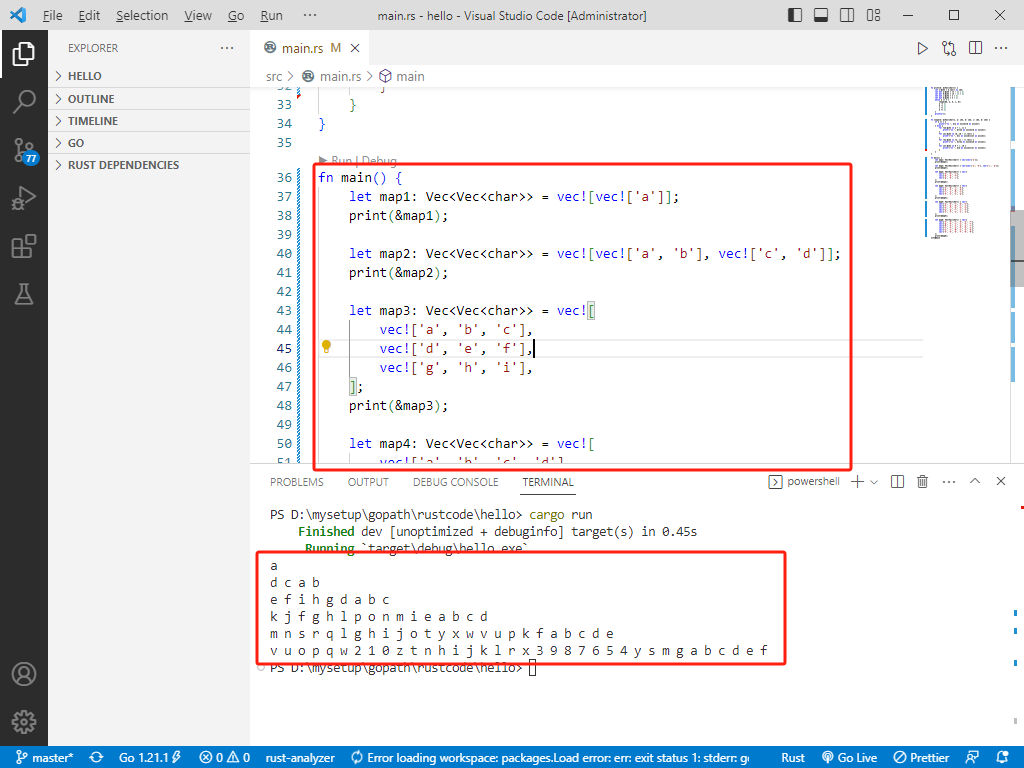2023-09-20:用 go 语言,保证一定是 n*n 的正方形,实现从里到外转圈打印的功能 如果 n 是奇数,中心点唯一,比如 a b c d e f g h i e 是中心点,依次打印 : e f i h g
- 2023-09-20 北京
本文字数:4024 字
阅读完需:约 13 分钟
2023-09-20:用 go 语言,保证一定是 n*n 的正方形,实现从里到外转圈打印的功能
如果 n 是奇数,中心点唯一,比如
a b c
d e f
g h i
e 是中心点,依次打印 : e f i h g d a b c
如果 n 是偶数,中心点为最里层 2*2 的右下点
比如
a b c d e f
g h i j k l
m n o p q r
s t u v w x
y z 0 1 2 3
4 5 6 7 8 9
最里层是
o p
u v
v 是中心点,依次打印 : v u o p q w ....
来自左程云。
答案 2023-09-20:
大体步骤如下:
1.定义一个函数 print,接收一个二维字节切片 m 作为参数。2.获取二维切片 m 的长度 n。3.设置四个变量 a, b, c, d 为(n-1)/2, (n-1)/2, n/2, n/2,分别表示每一层的起始点和终止点。4.使用循环,从最外层到最内层逐层打印。4.a.在每一层中,调用函数 loop 打印当前层的内容。5.在循环结束后,打印换行符。
函数 loop 的过程如下:1.判断如果 a 和 c 相等,表示只有一个元素,直接打印该元素并返回。2.对于其他情况,依次打印当前层的四个边。2.a. 从起始点的下一行开始,按列打印边界元素,即从上到下。2.b. 从终止点的左侧列开始,按行打印边界元素,即从右到左。2.c. 从终止点的上一行开始,按列打印边界元素,即从下到上。2.d. 从起始点的右侧列开始,按行打印边界元素,即从左到右。
在主函数 main 中,定义了几个测试用例,分别为不同大小的二维字节切片 m,然后调用 print 函数进行打印。
总的时间复杂度为 O(n^2),其中 n 为输入二维切片 m 的大小。
总的额外空间复杂度为 O(1),没有使用额外空间。
go 完整代码如下:
package main
import "fmt"
func print(m [][]byte) { n := len(m) for a, b, c, d := (n-1)/2, (n-1)/2, n/2, n/2; a >= 0; a, b, c, d = a-1, b-1, c+1, d+1 { loop(m, a, b, c, d) } fmt.Println()}
func loop(m [][]byte, a, b, c, d int) { if a == c { fmt.Printf("%c ", m[a][b]) } else { for row := a + 1; row <= c; row++ { fmt.Printf("%c ", m[row][d]) } for col := d - 1; col >= b; col-- { fmt.Printf("%c ", m[c][col]) } for row := c - 1; row >= a; row-- { fmt.Printf("%c ", m[row][b]) } for col := b + 1; col <= d; col++ { fmt.Printf("%c ", m[a][col]) } }}
func main() { map1 := [][]byte{{'a'}} print(map1)
map2 := [][]byte{{'a', 'b'}, {'c', 'd'}} print(map2)
map3 := [][]byte{{'a', 'b', 'c'}, {'d', 'e', 'f'}, {'g', 'h', 'i'}} print(map3)
map4 := [][]byte{{'a', 'b', 'c', 'd'}, {'e', 'f', 'g', 'h'}, {'i', 'j', 'k', 'l'}, {'m', 'n', 'o', 'p'}} print(map4)
map5 := [][]byte{{'a', 'b', 'c', 'd', 'e'}, {'f', 'g', 'h', 'i', 'j'}, {'k', 'l', 'm', 'n', 'o'}, {'p', 'q', 'r', 's', 't'}, {'u', 'v', 'w', 'x', 'y'}} print(map5)
map6 := [][]byte{{'a', 'b', 'c', 'd', 'e', 'f'}, {'g', 'h', 'i', 'j', 'k', 'l'}, {'m', 'n', 'o', 'p', 'q', 'r'}, {'s', 't', 'u', 'v', 'w', 'x'}, {'y', 'z', '0', '1', '2', '3'}, {'4', '5', '6', '7', '8', '9'}} print(map6)}

rust 完整代码如下:
fn print(m: &[Vec<char>]) { let n = m.len() as i32; let mut a = (n - 1) / 2; let mut b = (n - 1) / 2; let mut c = n / 2; let mut d = n / 2; while a >= 0 { loop2(&m, a, b, c, d); a -= 1; b -= 1; c += 1; d += 1; } println!();}
fn loop2(m: &[Vec<char>], a: i32, b: i32, c: i32, d: i32) { if a == c { print!("{} ", m[a as usize][b as usize]); } else { for row in a + 1..=c { print!("{} ", m[row as usize][d as usize]); } for col in (b..=d - 1).rev() { print!("{} ", m[c as usize][col as usize]); } for row in (a..=c - 1).rev() { print!("{} ", m[row as usize][b as usize]); } for col in b + 1..=d { print!("{} ", m[a as usize][col as usize]); } }}
fn main() { let map1: Vec<Vec<char>> = vec![vec!['a']]; print(&map1);
let map2: Vec<Vec<char>> = vec![vec!['a', 'b'], vec!['c', 'd']]; print(&map2);
let map3: Vec<Vec<char>> = vec![ vec!['a', 'b', 'c'], vec!['d', 'e', 'f'], vec!['g', 'h', 'i'], ]; print(&map3);
let map4: Vec<Vec<char>> = vec![ vec!['a', 'b', 'c', 'd'], vec!['e', 'f', 'g', 'h'], vec!['i', 'j', 'k', 'l'], vec!['m', 'n', 'o', 'p'], ]; print(&map4);
let map5: Vec<Vec<char>> = vec![ vec!['a', 'b', 'c', 'd', 'e'], vec!['f', 'g', 'h', 'i', 'j'], vec!['k', 'l', 'm', 'n', 'o'], vec!['p', 'q', 'r', 's', 't'], vec!['u', 'v', 'w', 'x', 'y'], ]; print(&map5);
let map6: Vec<Vec<char>> = vec![ vec!['a', 'b', 'c', 'd', 'e', 'f'], vec!['g', 'h', 'i', 'j', 'k', 'l'], vec!['m', 'n', 'o', 'p', 'q', 'r'], vec!['s', 't', 'u', 'v', 'w', 'x'], vec!['y', 'z', '0', '1', '2', '3'], vec!['4', '5', '6', '7', '8', '9'], ]; print(&map6);}

c++完整代码如下:
#include<iostream>#include<vector>
using namespace std;
void loop(vector<vector<char>> m, int a, int b, int c, int d);
void print(vector<vector<char>> m) { int n = m.size(); for (int a = (n - 1) / 2, b = (n - 1) / 2, c = n / 2, d = n / 2; a >= 0; a--, b--, c++, d++) { loop(m, a, b, c, d); } cout << endl;}
void loop(vector<vector<char>> m, int a, int b, int c, int d) { if (a == c) { cout << m[a][b] << " "; } else { for (int row = a + 1; row <= c; row++) { cout << m[row][d] << " "; } for (int col = d - 1; col >= b; col--) { cout << m[c][col] << " "; } for (int row = c - 1; row >= a; row--) { cout << m[row][b] << " "; } for (int col = b + 1; col <= d; col++) { cout << m[a][col] << " "; } }}
int main() { vector<vector<char>> map1 = { {'a'} }; print(map1);
vector<vector<char>> map2 = { {'a', 'b'}, {'c', 'd'} }; print(map2);
vector<vector<char>> map3 = { {'a', 'b', 'c'}, {'d', 'e', 'f'}, {'g', 'h', 'i'} }; print(map3);
vector<vector<char>> map4 = { {'a', 'b', 'c', 'd'}, {'e', 'f', 'g', 'h'}, {'i', 'j', 'k', 'l'}, {'m', 'n', 'o', 'p'} }; print(map4);
vector<vector<char>> map5 = { {'a', 'b', 'c', 'd', 'e'}, {'f', 'g', 'h', 'i', 'j'}, {'k', 'l', 'm', 'n', 'o'}, {'p', 'q', 'r', 's', 't'}, {'u', 'v', 'w', 'x', 'y'} }; print(map5);
vector<vector<char>> map6 = { {'a', 'b', 'c', 'd', 'e', 'f'}, {'g', 'h', 'i', 'j', 'k', 'l'}, {'m', 'n', 'o', 'p', 'q', 'r'}, {'s', 't', 'u', 'v', 'w', 'x'}, {'y', 'z', '0', '1', '2', '3'}, {'4', '5', '6', '7', '8', '9'} }; print(map6);
return 0;}

c 完整代码如下:
#include <stdio.h>
void loop(char** m, int a, int b, int c, int d);
void print(char** m, int n) { for (int a = (n - 1) / 2, b = (n - 1) / 2, c = n / 2, d = n / 2; a >= 0; a--, b--, c++, d++) { loop(m, a, b, c, d); } printf("\n");}
void loop(char** m, int a, int b, int c, int d) { if (a == c) { printf("%c ", m[a][b]); } else { for (int row = a + 1; row <= c; row++) { printf("%c ", m[row][d]); } for (int col = d - 1; col >= b; col--) { printf("%c ", m[c][col]); } for (int row = c - 1; row >= a; row--) { printf("%c ", m[row][b]); } for (int col = b + 1; col <= d; col++) { printf("%c ", m[a][col]); } }}
int main() { char* map1[] = { "a" }; int n1 = sizeof(map1) / sizeof(char*); print(map1, n1);
char* map2[] = { "ab", "cd" }; int n2 = sizeof(map2) / sizeof(char*); print(map2, n2);
char* map3[] = { "abc", "def", "ghi" }; int n3 = sizeof(map3) / sizeof(char*); print(map3, n3);
char* map4[] = { "abcd", "efgh", "ijkl", "mnop" }; int n4 = sizeof(map4) / sizeof(char*); print(map4, n4);
char* map5[] = { "abcde", "fghij", "klmno", "pqrst", "uvwxy" }; int n5 = sizeof(map5) / sizeof(char*); print(map5, n5);
char* map6[] = { "abcdef", "ghijkl", "mnopqr", "stuvwx", "yz0123", "456789" }; int n6 = sizeof(map6) / sizeof(char*); print(map6, n6);
return 0;}

版权声明: 本文为 InfoQ 作者【福大大架构师每日一题】的原创文章。
原文链接:【http://xie.infoq.cn/article/32dbb711f8386a57feaf5f200】。
本文遵守【CC-BY 4.0】协议,转载请保留原文出处及本版权声明。
福大大架构师每日一题
公众号:福大大架构师每日一题 2021-02-15 加入
公众号:福大大架构师每日一题











评论